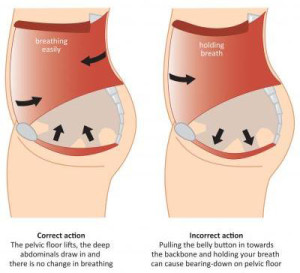Painful Pelvic Floor Tightness
 Diaphragmatic Breathing for Pelvic Stress Relief
Diaphragmatic Breathing for Pelvic Stress Relief
I have to admit, I didn’t think that I would see so many people in my office with tightness. Pelvic floor tightness that is. FYI: women don’t leak urine only because their muscles are weak and stretched out due to giving birth! I have seen women who have never had children as well as those who do, who suffer from incontinence and pain. Why is this? Often because of pelvic floor muscle restriction and tightness. Let’s dig into this a bit…
Pelvic Pressure
Beach bodies…strong abs; it’s what we all want, isn’t it? I remember learning as a teenager to suck in my stomach to achieve this flat stomach look that everyone wanted. Thankfully I have learned a few things since then! When we “suck in” or constantly try to hold our stomachs tight, we put unnecessary pressure on our abdominal cavity. This leads to chest breathing as well as increased pressure on our pelvic floor. In turn, our pelvic floor may work over time to compensate for the increased pressure. One of the roles of the pelvic floor is to support the internal organs within the pelvis (think: bladder, uterus, colon). If this muscle group is working overtime it has less of an ability to work well when necessary. Think of it this way: would you want to walk around constantly with your shoulders elevated? No, these muscles wouldn’t be able to function properly when you needed them. They could also become painful because they are working harder than they should, secondary to tightness and strain.
Pelvic Stress
Another common reason we have tightness in our pelvic floor is stress. Though most people think of holding stress in their neck, it’s extremely common to hold the pelvic floor muscles tight. A history of abuse, abdominal or pelvic surgery, low back pain, falling on the tailbone, car accidents, child birth or a painful sexual experience are all situations that I have seen lead to over-activity of the pelvic floor muscles.
Diaphragmatic Breathing for Relief from Pelvic Floor Tightness
Here’s where the breath comes in. One of the best treatments for this tightness is diaphragmatic breathing. When we stop to focus our breath for a few minutes a day it creates awareness of our bodies. It’s like checking in: am I slouched, holding my head forward, holding tightness anywhere in the body? As I do this I can release areas of tightness or terrible positioning (let’s face it, we all slouch at times!), I can stretch or move restricted muscles.
- By decreasing tension and changing positions, we can help to decrease our pain.
- Through breathing with a soft belly, we can actually help with core stability when we need it (more on the core in a future post!).
- And lastly, we can calm our nervous system with pausing and focusing on deep, slow breaths. This is how we were designed to breathe anyway. Have you ever watched a baby sleep? Take a look at their bellies and see how they rise with each inhalation.
Let’s practice:
- Lie on your back with a pillow under knees to start.

- As you breathe in allow your stomach to rise up and out. This doesn’t have to be forceful, but it may take some practice for some people. As you inhale, there is a natural lengthening of the pelvic floor muscles, meaning a downward movement toward your feet. Imagine the space between your sitting bones to open and widen, allowing room for the pelvic floor muscles to expand. This allows for relaxation of the pelvic floor.
Alternative positions include child’s pose from Yoga or a deep squat. But belly breathing can also be incorporated and should eventually transferred to every day positions and tasks such as sitting at a desk, while driving, before falling asleep, as part of an exercise program or meditation.
If you are struggling with pelvic pain, incontinence, or restriction in your muscles, please call me at 518-632-4944 for an evaluation. A full body screen (including the pelvic floor) can help guide you in a specific program to get you back on the right track.
Related Posts:
